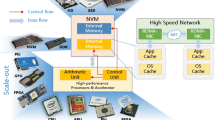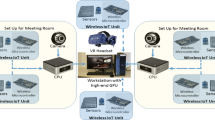Abstract
Managing the geometry of a 3D scene efficiently is a key aspect of an interactive 3D application. This aspect is more important if we target at portable devices, which have limited hardware capabilities. Developing new means for improving the interaction with 3D content in mobile devices is key. The aim of this work is to present a technique which can manage the level-of-detail of 3D meshes in portable devices. This solution has been devised considering the restrictions that this kind of devices poses. The results section shows how the integration has been successful while obtaining good performance.









Similar content being viewed by others
References
Baek N, Lee H (2012) OpenGL ES 1.1 implementation based on OpenGL. Multimedia Tools Appl 57:669–685
Boubekeur T, Schlick C (2008) A flexible kernel for adaptive mesh refinement on GPU. Comput Graph Forum 27(1):102–114
Castello P, Chover M, Sbert M, Feixas M (2007) Applications of information theory to computer graphics (part 7). In: Eurographics tutorial notes, vol 2, pp 891–902
Chan MC, Hu SY, Jiang JR (2009) Secure peer-to-peer 3d streaming. Multimedia Tools Appl 45:369–384
Clark J (1976) Hierarchical geometric models for visible surface algorithms. Commun ACM 10(19):547–554
Cohen J, Olano M, Manocha D (1998) Appearance-preserving simplification. In: SIGGRAPH ’98, pp 115–122
Cyberware (2012) 3D scanner samples. http://www.cyberware.com/products/scanners/msSamples.html (accessed 25 June 2012)
Giegl M, Wimmer M (2007) Unpopping: solving the image-space blend problem for smooth discrete lod transitions. Comput Graph Forum 26(1):46–79
Gonzalez C, Gumbau J, Chover M, Castello P (2008) Mesh simplification for interactive applications. In: WSCG, pp 87–94
Hoppe H, DeRose T, Duchamp T, McDonald J, Stuetzle W (1993) Mesh optimization. In: Computer graphics 27 (annual conference series), pp 19–26
Hu L, Sander PV, Hoppe H (2009) Parallel view-dependent refinement of progressive meshes. In: I3D ’09: Proceedings of the 2009 symposium on interactive 3D graphics and games, pp 169–176
Kim SK, An SO, Hong M, Park DS, Kang SJ (2010) Decimation of human face model for real-time animation in intelligent multimedia systems. Multimedia Tools Appl 47:147–162
Lindstrom P, Turk G (2000) Image-driven simplification. ACM Trans Graph 19(3):204–241
Luebke D, Hallen B (2001) Perceptually-driven simplification for interactive rendering. In: 12th Eurographics workshop on rendering, pp 223–234
Luebke D, Reddy M, Cohen J, Varshney A, Watson B, Huebner R (2003) Level of detail for 3D graphics. Morgan Kaufmann, San Mateo
Ramos F, Chover M (2004) Lodstrips: level of detail strips. In: ICCS, vol 3039, pp 107–114
Ripolles O, Chover M (2008) Optimizing the management of continuous level of detail models on GPU. Comput Graph 32(3):307–319
Ripolles O, Chover M, Ramos F (2011) Visualization of level-of-detail meshes on the GPU. Vis Comput 27:793–809
Sander P, Snyder J, Gortler S, Hoppe H (2001) Texture mapping progressive meshes. In: SIGGRAPH 2001, pp 409–416
Shafae M, Pajarola R (2003) Dstrips: dynamic triangle strips for real-time mesh simplification and rendering. In: Pacific Graphics conference, pp 271–280. Strips, Multiresolution
Southern R, Gain J (2003) Creation and control of real-time continuous level of detail on programmable graphics hardware. Comput Graph Forum 22(1):35–48
Stanford (2012) The Stanford 3D scanning repository. http://www.graphics.stanford.edu/data/3Dscanrep (accessed 25 June 2012)
Turchyn P (2007) Memory-efficient sliding window progressive meshes. In: Proc. of 15-th international conference in central Europe on computer graphics, visualization and computer vision (WSCG 2007), pp 33–40
Wikipedia (2011) Apple a4. http://en.wikipedia.org/wiki/Apple_A4 (accessed 10 December 2011)
Wikipedia (2011) Apple a5. http://en.wikipedia.org/wiki/Apple_A5 (accessed 10 December 2011)
Xia J, El-Sana J, Varshney A (1997) Adaptative real-time level-of-detail-based rendering for polygonal models. IEEE Trans Vis Comput Graph 3(2):171–183
Zach C (2002) Integration of geomorphing into level of detail management for realtime rendering. In: SCCG 2002
Acknowledgements
This work was supported by the Spanish Ministry of Science and Technology (Project TIN2010-21089-C03-03) and Feder Funds, Bancaixa (Project P1.1B2010-08) and Generalitat Valenciana (Project PROMETEO/2010/028).
Author information
Authors and Affiliations
Corresponding author
Rights and permissions
About this article
Cite this article
Ramos, F., Ripolles, O. & Chover, M. Efficient visualization of 3D models on hardware-limited portable devices. Multimed Tools Appl 73, 961–976 (2014). https://doi.org/10.1007/s11042-012-1200-3
Published:
Issue Date:
DOI: https://doi.org/10.1007/s11042-012-1200-3




